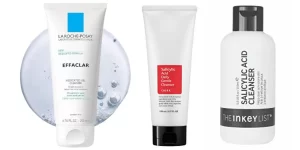
If you struggle with acne, clogged pores, or oily skin, then you’re probably no stranger to salicylic acid. But, have you ever used a salicylic acid product only to feel a burning or tingling sensation on your skin?

Yikes! That can be concerning. But wait, should salicylic acid burn? Let’s investigate what salicylic acid is, how it works, and what would make it cause a burning sensation.
Read next: 10 Fantastic + Gentle Salicylic Acids for Sensitive Skin
What is salicylic acid?
So, what even is salicylic acid? Well, it is a type of beta hydroxy acid (BHA) derived from a natural compound found in willow bark.
And is commonly used in skincare products to help exfoliate the skin and unclog pores.
But, how does it work?
Salicylic acid is oil-soluble, which means it’s able to penetrate deep into the pores and break down the excess oil and dead skin cells that can cause acne and other skin issues.
This exfoliation process helps to unclog pores and prevent future breakouts.
Should salicylic acid burn?
Can salicylic acid cause burning? Unfortunately, yes.
Salicylic acid can irritate the skin, particularly if used in high concentrations or if the pH level of the product is too low.
When salicylic acid is applied to the skin, it can cause a slight tingling or burning sensation.
This is often normal and can be a sign that the product is working.
However, if the burning sensation is severe, it may be a sign of irritation and you should stop using the product immediately.
But, why does salicylic acid cause burning in the first place?
Well, salicylic acid is a type of acid after all.
When applied to the skin, acids can disrupt the skin’s natural pH balance and cause irritation.
Some people may be sensitive or allergic to salicylic acid, which can result in burning or redness.
The good news is there are precautions you can take to minimize the risk of burning.
Always patch-test a new product on a small area of your skin before applying it all over your face, and start with a lower concentration product and work your way up if needed.
And of course, always follow the instructions on the product label.
Factors that can increase the risk of burning, such as concentration and pH level
Now, let’s dive a bit deeper into the factors that can increase the risk of burning from salicylic acid.
First is the concentration of the product. Salicylic acid products come in varying strengths, from 0.5% to 30%.
If you’re new to salicylic acid, it’s best to start with a lower concentration and gradually work your way up to a higher one if needed.
This will give your skin time to adjust and minimize the risk of irritation or burning.
Next, is the pH level of the product.
The ideal pH level for salicylic acid to work effectively is between 3 and 4.
If the pH level is too low, it can cause irritation and burning. So, it’s important to choose products with the right pH level for your skin.
Another factor that can increase the risk of burning is overuse.
Using salicylic acid too frequently or applying too much product can cause irritation and dryness, which can lead to burning.
So follow the instructions on the product label and don’t use more than recommended.
Last, we have skin type.
People with sensitive or dry skin may be more prone to burning from salicylic acid, so it is important to listen to your skin and adjust your routine accordingly.
If you experience burning or irritation, reduce the frequency of use or switch to a gentler product.
Remember, the key to using salicylic acid safely and effectively is to start slow and pay attention to your skin’s reaction.
Don’t be afraid to adjust your routine or seek advice from a dermatologist if needed.
Precautions to take to avoid burning
Now that we’ve covered the factors that can increase the risk of burning from salicylic acid, let’s talk about some precautions you can take to avoid it altogether.
- First and foremost, it’s important to patch-test any new product. Apply a small amount of the product to a small area of your skin and wait at least 24 hours to see if you have any adverse reactions.
- Next, start with a lower-concentration product and gradually work your way up if needed. This will give your skin time to adjust and minimize the risk of irritation or burning.
- Follow the instructions on the product label. Don’t use more product than recommended or use it more frequently than instructed. Overuse can lead to irritation and burning.
- Choose products with the right pH level for your skin. The ideal pH level for salicylic acid to work effectively is between 3 and 4. If the pH level is too low, it can cause irritation and burning.
- Listen to your skin. If you experience burning, redness, or irritation, stop using the product immediately. Give your skin time to recover before reintroducing the product at a lower concentration or switching to a gentler product.
Is a burning or tingling sensation ever normal?
Now, let’s talk about when “burning” from salicylic acid could be considered normal.
Don’t worry, I’m not trying to confuse you – there are instances where a tingling or slight burning sensation may be perfectly expected when using salicylic acid products.
When salicylic acid is applied to the skin, it works to exfoliate and unclog pores.
This can cause a slight tingling or burning sensation, especially if you’re using a higher-concentration product.
In fact, many people actually find this sensation to be satisfying because they view it as a sign that the product is working.
So, how do you know if the burning sensation is normal or a sign of irritation?
Typically, a “normal” burning or tingling sensation will be mild and subside within a few minutes.
If the burning sensation is severe, lasts for a long time, or is accompanied by redness or irritation, it may be a sign of irritation and you should stop using the product immediately.
If you’re unsure if the burning sensation you’re experiencing is normal, start with a lower-concentration product and gradually work your way up if needed.
And of course, always listen to your skin – if it doesn’t feel right, it probably isn’t.
When should you be concerned about burning and seek medical attention
While a tingling or slight burning sensation is generally considered normal when using salicylic acid products, there are instances where burning can be a sign of a more serious issue.
If you experience any of the following symptoms, it’s important to seek medical attention:
- Severe burning: If the burning sensation is severe and doesn’t subside after a few minutes, it may be a sign of a chemical burn. If that’s the case, then stop using the product immediately and seek medical attention.
- Redness and irritation: If the burning sensation is accompanied by redness, irritation, or a rash, it may be a sign of an allergic reaction. Seek medical attention.
- Swelling: If the area around where the product was applied is swelling, it may be a sign of an allergic reaction. Stop and immediately seek medical attention.
- Difficulty breathing: In rare cases, a severe allergic reaction to salicylic acid can cause difficulty breathing, swelling of the face, throat, or tongue, and other symptoms.
If you experience any of these symptoms, it’s always advisable to consult a medical professional. It’s better to be safe than sorry when it comes to your health.
If you’re experiencing any symptoms that concern you, stop using the product and seek medical attention. It’s better to be safe than sorry!
Alternatives to salicylic acid
If you’re sensitive to salicylic acid or just looking for an alternative, don’t worry, there are plenty of other options out there!
Here are a few other types of acids and ingredients that can be used to treat skin concerns similar to salicylic acid:
- Glycolic acid: This alpha-hydroxy acid (AHA) is great for exfoliating and brightening the skin. It’s a great option for those with oily or acne-prone skin.
- Lactic acid: Another AHA, lactic acid is a great option for those with dry or sensitive skin. It helps to exfoliate and hydrate the skin at the same time.
- Mandelic acid: This AHA is great for those with sensitive skin or rosacea. It’s gentler than some other AHAs but still works to exfoliate and improve the texture of the skin.
- Benzoyl peroxide: This ingredient is great for treating acne and works by killing the bacteria that cause breakouts. It can be drying, so it’s important to use a moisturizer when using benzoyl peroxide.
Final thoughts
Remember, a tingling or slight burning sensation may be normal when using salicylic acid products, but if the burning is severe or accompanied by other symptoms, it’s important to stop using the product and seek medical attention.
Salicylic acid can be a great addition to your skincare routine, but it’s important to use it safely and effectively.
By taking the necessary precautions and being mindful of your skin’s reactions, you can enjoy all the benefits of salicylic acid without any burning or irritation.



